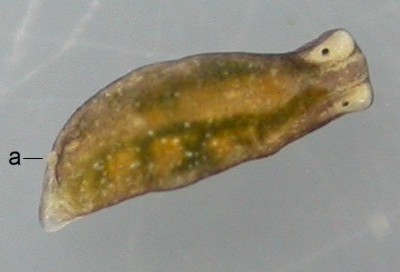
Limapontia depressa
Alder & Hancock, 1862
Order: SACOGLOSSA
Superfamily: LIMAPONTIOIDEA
Family: Limapontiidae
DISTRIBUTION
Atlantic coast of Europe from Baltic to SW France - on saltmarshes.
PHOTO
Locality: Church Island, Menai, Anglesey, intertidal, Wales, U.K., Irish Sea, 17 October 2009, intertidal mud flat, full salinity. Length: 3.5 mm. Photographer: Ian F. Smith. [a = anus]
This small inconspicuous sacoglossan grows to approximately 6 mm in length. It usually ranges in colour from dark brown to black with paler regions around the eyes, but there is a variety reported which is much paler in colout and in which the darker digestive gland can be seen through the body wall.
Externally it can be distinguished from L. capitata and L. senestra by the lack of any sign of head tentacles, although this is not always easy when comparing it with L. capitata. However L. depressa is distinct in the position of the anus and renal openings. In all three species the openings are approxinately in the dorsal midline. In L. depressa the anus is near the posterior end of the body while the renal opening is some distance away, about one-third of the length of the body from the posterior tip. In the other two species, both openings are quite close together about one-third of the length of the body from the posterior tip.
Thompson reports it to be a common inhabitant, with Alderia modesta, of British saltmarshes as well as continental Europe. It is rarely found in pools, but usually on damp mud, crawling and feeding on the alga Vaucheria. Its salinity tolerance is not great preferring approx 25% seawater. This species has swimming, feeding planktotrophic larvae.
-
Chia, F. S. (1971). Oviposition, Fecundity, and Larval Development of three sacoglossan opisthobranchs from the Northumberland Coast, England. The Veliger 13(4): 319-325.
-
Hartog, C. D. and C. Swennen (1952). On the occurrence of Alderia modesta (Lovén) and Limapontia depressa A. & H. on the salt marshes of the Dutch Waddenzee (Gastropoda, Nudibranchia). Beaufortia, Zoological Museum, Amsterdam 19: 1-3.
-
Quick, H. E. (1950). Observations on Limapontia. Proceedings of the Malacological Society of London 28(4-5): 134-138
-
Thompson, T.E. (1976) Biology of Opisthobranch Molluscs. Volume 1. The Ray Society, London. 207pp.
Rudman, W.B., 2009 (November 4) Limapontia depressa Alder & Hancock, 1862. [In] Sea Slug Forum. Australian Museum, Sydney. Available from http://www.seaslugforum.net/find/limadepr
Related messages
Photographs of 2 Sacoglossans of the Dutch saltmarshes [2]
November 27, 2009
From: Marianne Ligthart
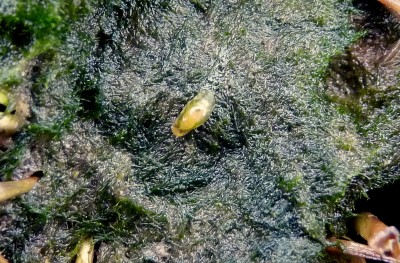
Concerning message #22783:
Dear Bill.
I understand you regret there are too few photographs of Alderia modesta on the Forum. So I am sending you some recent photographs of Alderia modesta [message #22841] and Limapontia depressa taken in the field (on the saltmarshes in the south-west part of our country near estuarine coastal waters). I regularly find both species throughout the year, exept in periods when it is very cold or dry.
The animals mostly are very small in size: 2 - 3 mm and they live on Vaucheria spec.
Locality: saltmarshes in the south-west part of the country near estuarine, coastal waters, / on saltmarshes, the Netherlands, estuarine waters of the North Sea, autumn 2008, on saltmarshes on Vaucheria spec.. Length: 2 - 3 mm. Photographer: Marianne Ligthart.
With greetings:
Marianne Ligthart
ahmligthart@hetnet.nl
Ligthart, M., 2009 (Nov 27) Photographs of 2 Sacoglossans of the Dutch saltmarshes [2]. [Message in] Sea Slug Forum. Australian Museum, Sydney. Available from http://www.seaslugforum.net/find/22863
Dear Marianne,
Thanks for this photo of Limapontia depressa 'at home'. We can clearly see the branching green digestive gland through the semi-transparent skin which we discussed in earlier messages.
Best wishes,
Bill Rudman
Identity of Limapontia depressa.
November 20, 2009
From: Ian Smith
Concerning message #22781:
Dear Bill
As you suggested some reservations about the determination of my L. depressa specimens, here is some more detail.
My Orkney specimens [message #22743] were dissected by Tom Gascoigne, whom Kathe mentioned, and he confirmed my det.. I have hunted out my correspondence with him. He commented about them that "at X25 only the anus could be seen", so I am not surprised that I haven't found a completely convincing view of the renal pore.
However, my uncontested L. capitata has anus and renal pore clearly visible in the appropriate adjacent positions for that species, and I am sure my brown specimens from Menai do not have openings in the L. capitata position.
You mentioned difficulty in using photographs for det. of Limapontia spp. This certainly applies to black specimens, so I would suggest replacing the Orkney photo with the brown specimens on message #22763 as the primary image on the L. depressa factsheet , as they show much more detail (sub-terminal anus, lack of pale metapodium, green branched gut, absence of rhinophores or crest.)
The sub-terminal anus is sufficient alone to separate them from the other two Limapontia spp..
In J. Conch. 28: 360 (1975) Tom says " They (L. depressa) show two adaptations for life on land - a thick coat of mucus to prevent water-loss and a sub-terminal anus for the efficient removal of faecal matter. --- they could be called amphibious".
The glistening mucus can be seen on my image of the specimen on the algal mat. I took several photos of L. depressa on the mat, and this was selected as the clearest; on the others the mucus was so thick it obscured most detail of the animal.
I have examined the algal mat closely, and it contains cellular and non-cellular filaments. So the cellular pieces seen by Skip in the photo do not preclude Vaucheria (as Skip also said in his second message #22780).
I have noted some interesting details of the feeding of L. depressa, so thanks for pushing me to re-examine them. I'll save the details for another posting.
- Gascoigne, T. (1975). A Field Guide to the British Limapontiidae and Alderia modesta Loven. Journal of Conchology 28: 359-364.
Best wishes
Ian
ifsmith@bethere.co.uk
Ian F. Smith, 2009 (Nov 20) Identity of Limapontia depressa.. [Message in] Sea Slug Forum. Australian Museum, Sydney. Available from http://www.seaslugforum.net/find/22821Dear Ian,
Thanks for the background information. I have changed the Fact Sheet photo. Identification keys often make things sound very easy, but as the Limapontiidae show us, they seldom are.
Best wishes,
Bill Rudman
Re: Limapontia capitata on Vaucheria
November 13, 2009
From: Kathe R. Jensen
Concerning message #22765:
Dear Bill and Skip,
If I remember Tom Gascoigne's old papers correctly, Limapontia depressa will also feed on Rhizoclonium. This green filamentous alga is very similar to Chaetomorpha, but filaments are usually finer and there are short branches towards the bases of the filaments.
Kathe R. Jensen
krjensen@snm.ku.dk
Jensen, K.R., 2009 (Nov 13) Re: Limapontia capitata on Vaucheria. [Message in] Sea Slug Forum. Australian Museum, Sydney. Available from http://www.seaslugforum.net/find/22781Dear Kathe,
In your earlier message [#22758] you mention that Rhizoclonium and Vaucheria co-occur so it certainly raises the possibility that Vaucheria is in the locality - we just can't see it in the photos.
I haven't got a copy of Tom Gascoigne's paper at hand but in Biology of Opisthobranch Molluscs Tom Thompson (1976) cites records from Gascoigne and others on feeding in Limapontia. L. capitata is recorded to feed on various filamentous green algae including Cladophora spp, Enteromorpha spp, and Bryopsis sp. while L. senestra is reported to feed on Cladophora sp. Vaucheria is the only food item reported for L. depressa.
This indeed is another example for anyone in Europe looking for a research project - you don't need to travel to exotic places to find interesting puzzles
- Gascoigne, T (1956). Feeding and reproduction in the Limapontiidae. Transactions of the Royal Society of Edinburgh 63: 129-151
Best wishes,
Bill Rudman
Re: Limapontia capitata on Vaucheria
November 13, 2009
From: Skip Pierce
Concerning message #22765:
Hi Bill
I'm thinking that I really need to let an algologist take over this discussion. My experience with Vaucheria does not extend any further than V. litorea and V. compacta from salt marshes in New England and the Canadian maritimes. I am not sure what species of it may be present in the Wales' marshes. I am also not trying to say at all (and do not think should be concluded from the photos here) that L. depressa is not eating Vaucheria (sorry for the triple negative). Only that it is impossible (for me) to say from Ian's macro photos of the algal mats in the marshes what species of algae are present-except that there are surely more than one. Also, his higher magnification photo of the egg mass confirms that there is more than one algal species and none in his photo are Vaucheria for the reasons in my earlier message. That does not mean that Vaucheria is not present elsewhere in the mats. Also, as a last comment, the Vaucheria species that I know grow attached to the sediments, not epiphytic on other algae.
Skip Pierce
pierce@cas.usf.edu
Pierce, S. K., 2009 (Nov 13) Re: Limapontia capitata on Vaucheria. [Message in] Sea Slug Forum. Australian Museum, Sydney. Available from http://www.seaslugforum.net/find/22780Thanks Skip,
I am sure the ongoing discussion has given Ian some clues on what to look for next
Best wishes,
Bill Rudman
Re: Limapontia capitata on Vaucheria
November 12, 2009
From: Skip Pierce
Concerning message #22763:
Most of the algal filaments in the photo showing the egg mass are NOT Vaucheria, and I do not see any that I could say for sure are that species. You might reasonably ask what species are they then? - and I can't tell you that from the photo (Chaetomorpha might be a good start, but could be others), but you can clearly see cells in most of them.
Skip
pierce@cas.usf.edu
Pierce, S. K., 2009 (Nov 12) Re: Limapontia capitata on Vaucheria. [Message in] Sea Slug Forum. Australian Museum, Sydney. Available from http://www.seaslugforum.net/find/22765Thanks Skip,
I suspected I could see cell walls so am glad to get your confirmation. If the published information on Limapontia depressa is correct, and it only feeds on Vaucheria, then we not only have an identity problem witht yhe algae but also with the Limapontia. To say anything sensible I think we need a photo of the algae at higher magnification and a hunt for the kidney opening. Is it possible that small strands of Vaucheria are living epiphytically on the filamentous green algae?
Best wishes,
Bill Rudman
Re: Limapontia capitata on Vaucheria
November 9, 2009
From: Ian Smith
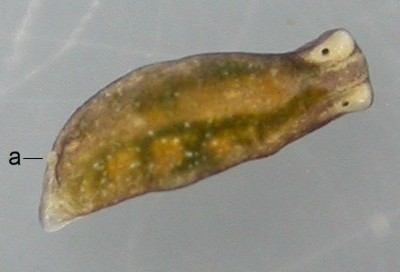
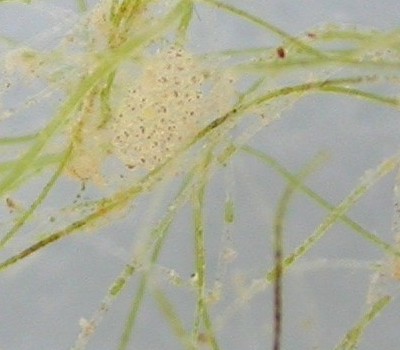
Concerning message #22752:
Dear Bill, Kathe and Skip
Many thanks for your helpful responses.
Bill asked if I had viewed the specimens under a binocular microscope. Yes, but I was not sure if I was discerning the anus and renal opening.
I spent much time yesterday watching the brown specimens, and was able to identify the anus when they defecated streams of cloudy grey-white matter. In the pictures attached, it is a pore at the anterior of a pale streak near the posterior of one specimen, and it protrudes as a papilla labelled 'a' on the other picture.
I think the renal opening is the pale pore visible centrally on both pictures, but can not be sure.
In the three weeks since I collected the specimens, they have grown a little, now 3.5 mm, the brown ridges between the eyes have flattened, and over ten spawn masses have been deposited on Vaucheria (picture attached).
I am now convinced that the brown specimens are Limapontia depressa for the following reasons:
1. anus near posterior.
2. found on Vaucheria on mud, out of water at high tide.
3. Dark green branched digestive gland visible.
4. At no time was an elongated metapodium extended.
5. The brown ridges I mistook for crests have flattened and they were not pale.
6. The veligers visible in the spawn have black pigment as mentioned by Tom Thompson for L. depressa.
I hope this is enough to gain your agreement.
Re point 6; T.E.T. did not mention black pigment for the veligers of L. capitata or L. senestra, but "absence of mention" doesn't equate with "mention of absence"; he only shows a bursal streak on the drawing of L. capitata, but I can see it clearly on my brown L. depressa specimens. Kathe, do you know if L. capitata or L. senestra veligers have black pigment?
This leaves the uncontested dark L. capitata specimen of my first posting (now 5mm). It was found in the pool shown. I think it can be accounted for by the strong tidal rapid of the adjacent Swellies which sweeps along items that are deposited 'out of habitat' in the calmer bay. On a previous occasion I found a shoal of a pelagic sp. of goby, usually found in the rapids, stranded in the same pool.
Locality: Church Island, Menai, Anglesey, intertidal, Wales, U.K., Irish Sea, 17 October 2009, intertidal mud flat, full salinity. Length: 3.5 mm. Photographer: Ian F. Smith.
Thanks again for your help.
Best wishes
Ian
ifsmith@bethere.co.uk
Smith, I.F., 2009 (Nov 9) Re: Limapontia capitata on Vaucheria. [Message in] Sea Slug Forum. Australian Museum, Sydney. Available from http://www.seaslugforum.net/find/22763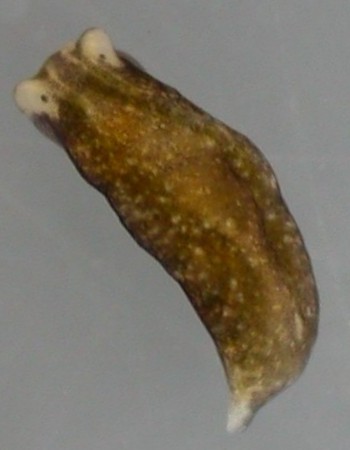
Dear Ian,
I am glad you reached that conclusion - it is what I suspected, but from photos alone I couldn't be sure. Limapontia senestra has very large eggs and direct developing larvae so even without the obvious tentacles, we can cancel it from the discussion. Concerning the renal opening - it is often quite hard to see, not only in sacoglossans, but all opisthobranchs. In the photo with an 'a' I would suspect the renal opening would be in or near the small pale patch in the midline about one third the way along the body from the 'tail'. Certainly the shortened 'tail' and the position of the anus so far back on the body suggests these paler animals are L. depressa.
Best wishes,
Bill Rudman
Limapontia depressa from Orkney Islands, UK
November 5, 2009
From: Ian F. Smith
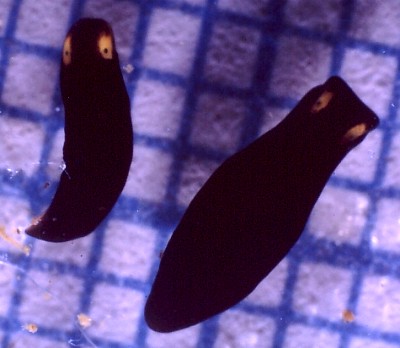
Dear Bill
You may like to use the attached picture of Limapontia depressa from the Ouse, Finstown, Orkney islands, U.K. The Ouse can be seen in my habitat photo.
In the picture it is nearing high tide, so the mud with filamentous algae is covered. The sea comes in under the road causeway on the left. Salinity is reduced by a burn [small stream] flowing in.
Locality: The Ouse, Finstown, intertidal, Orkney, Scotland, North Atlantic, 24 April 1975, Intertidal mud in brackish enclosed arm of a bay . Length: 4 mm. Habitat photo at http://www.geograph.org.uk/photo/235398 Photographer: Ian F. Smith.
Best wishes
Ian (Smith)
ifsmith@bethere.co.uk
Smith, I.F., 2009 (Nov 5) Limapontia depressa from Orkney Islands, UK. [Message in] Sea Slug Forum. Australian Museum, Sydney. Available from http://www.seaslugforum.net/find/22743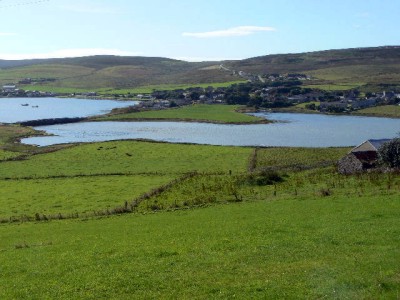
Dear Ian,
Thanks for this. We didn't have a photo of Limapontia depressa so this is a welcome addition. I must say I sometimes wonder if it is possible to distinguish this species from L. capitata just from photos. The difference in head morphology is not that easy to see and unless we have very high magnification the difference in placing of the anus and renal openings [close together in L. capitata and far apart in L. depressa] can't be seen.
Best wishes,
Bill Rudman
